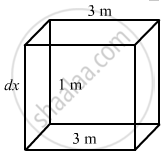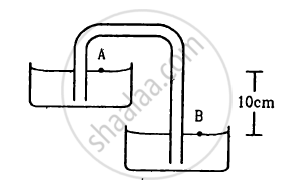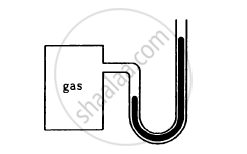Advertisements
Advertisements
प्रश्न
Water is filled in a rectangular tank of size 3 m × 2 m × 1 m. (a) Find the total force exerted by the water on the bottom surface on the tank. (b) Consider a vertical side of area 2 m × 1 m. Take a horizontal strip of width δx metre in this side, situated at a depth of x metre from the surface of water. Find the force by the water on this strip. (c) Find the torque of the force calculate in part (b) about the bottom edge of this side.
(d) Find the total force by the water on this side.
(e) Find the total torque by the water on the side about the bottom edge. Neglect the atmospheric pressure and take g = 10 ms−2.
उत्तर
Dimensions of the rectangular tank:
Length, l = 3 m
Breadth, b = 2 m
Height, h = 1 m
Area of the bottom surface of the tank, A = 2 × 3 = 6 m2
Density of water, ρw = 1000 kgm−3

(a) Total force exerted by water on the bottom surface of the tank:
\[ \text{ f = Ah}\rho_\text{w g}\]
\[ = 6 \times 1 \times {10}^3 \times 10\]
\[ = 6 \times {10}^4 = 60, 000 \text{N} \]
(b) Force exerted by water on the strip of width δx:
\[\text{ df = p } \times \text{ A } = \left( \text{ x}\rho_\text{w g} \right) \times A\]
\[ = \text{x} \times {10}^3 \times 10 \times 2 \times \delta \text{x} \]
\[ = 20, 000\text{x}\delta \text{x N}\]
(c) Inside the tank, the water force acts in every direction due to adhesion. Therefore, torque is given by
\[\text{di} = F \times r\]
\[ = 20, 000 \times \delta x(1 - x) N\]
(d) Total force exerted by water on the side about the bottom edge (F) :
\[\text{F} = \int_0^1 20, 000 \text{ x}\delta\text{ x}\]
\[ \Rightarrow F = 20, 000 \left[ \frac{\text{x}^2}{2} \right]_0^1 \]
\[ = 10, 000 \text{N}\]
(e) Torque by the water on the side (T):
\[\tau = 20, 000 \times \int_0^1 \text{x}\delta \text{x}\left( 1 - x \right)\]
\[ = 20, 000 \left[ \frac{\text{x}^2}{2} - \frac{\text{x}^3}{3} \right]_0^1 \]
\[ = 20, 000 \times \left[ \frac{1}{2} - \frac{1}{3} \right]\]
\[ = \frac{20, 000}{6} \text{ Nm }= \frac{10000}{3} \text{ Nm } \]
APPEARS IN
संबंधित प्रश्न
A U-tube contains water and methylated spirit separated by mercury. The mercury columns in the two arms are in level with 10.0 cm of water in one arm and 12.5 cm of spirit in the other. What is the specific gravity of spirit?
During blood transfusion the needle is inserted in a vein where the gauge pressure is 2000 Pa. At what height must the blood container be placed so that blood may just enter the vein? [Use the density of whole blood from Table 10.1].
A barometer tube reads 76 cm of mercury. If the tube is gradually inclined keeping the open end immersed in the mercury reservoir, will the length of mercury column be 76 cm, more than 76 cm or less than 76 cm?
A one meter long glass tube is open at both ends. One end of the tube is dipped into a mercury cup, the tube is kept vertical and the air is pumped out of the tube by connecting the upper end to a suction pump. Can mercury be pulled up into the pump by this process?
Equal mass of three liquids are kept in three identical cylindrical vessels A, B and C. The densities are ρA, ρB, ρC with ρA < ρB < ρC. The force on the base will be
Shows in the following figure a siphon. The liquid shown is water. The pressure difference PB − PAbetween the points A and B is
Suppose the pressure at the surface of mercury in a barometer tube is P1 and the pressure at the surface of mercury in the cup is P2.
A barometer kept in an elevator reads 76 cm when it is at rest. If the elevator goes up with increasing speed, the reading will be ______.
The surface of water in a water tank on the top of a house is 4 m above the tap level. Find the pressure of water at the tap when the tap is closed. Is it necessary to specify that the tap is closed?
The heights of mercury surfaces in the two arms of the manometer shown in figure are 2 cm and 8 cm.
Atmospheric pressure = 1.01 × 105 N−2. Find (a) the pressure of the gas in the cylinder and (b) the pressure of mercury at the bottom of the U tube.

The weight of an empty balloon on a spring balance is W1. The weight becomes W2when the balloon is filled with air. Let the weight of the air itself be w. Neglect the thickness of the balloon when it is filled with air. Also neglect the difference in the densities of air inside and outside the balloon.
(a) W2 = W1
(b) W2 = W1 + w
(c) W2 < W1 + w
(d) W2 > W1
A closed vessel is half filled with water. There is a hole near the top of the vessel and air is pumped out from this hole.
(a) The water level will rise up in the vessel.
(b) The pressure at the surface of the water will decrease
(c) The force by the water on the bottom of the vessel will decrease
(d) The density of the liquid will decrease
Water leaks out from an open tank through a hole of area 2 mm2 in the bottom. Suppose water is filled up to a height of 80 cm and the area of cross section of the tanks is 0.4 m2. The pressure at the open surface and at the hole are equal to the atmospheric pressure. Neglect the small velocity of the water near the open surface in the tank. (a) Find the initial speed of water coming out of the hole. (b) Find the speed of water coming out when half of water has leaked out. (c) Find the volume of eater leaked out using a time interval dt after the height remained is h. Thus find the decrease in height dh in terms of h and dt.
(d) From the result of park (c) find the time required for half of the water to leak out.
Considering the pressure p to be proportional to the density, find the pressure p at a height h if the pressure on the surface of the earth is p0.
A glass capillary sealed at the upper end is of length 0.11 m and internal diameter 2 × 10-5 m. This tube is immersed vertically into a liquid of surface tension 5.06 × 10-2 N/m. When the length x × 10-2 m of the tube is immersed in liquid then the liquid level inside and outside the capillary tube becomes the same, then the value of x is ______ m. (Assume atmospheric pressure is 1.01 × 105 `"N"/"m"^2`)
